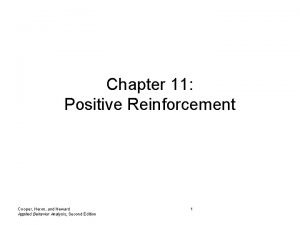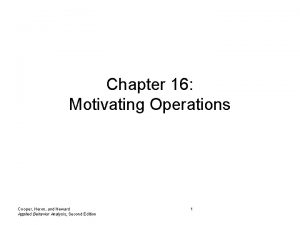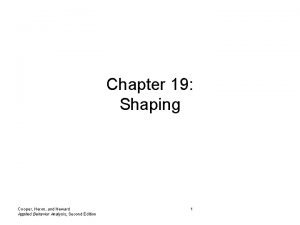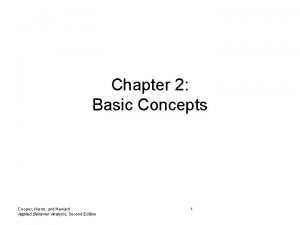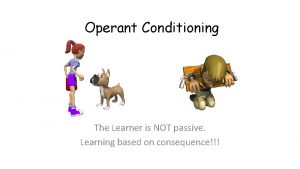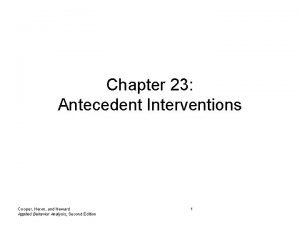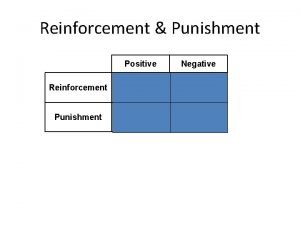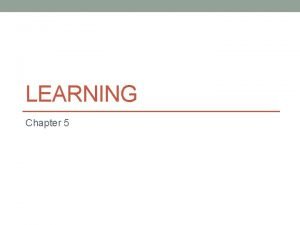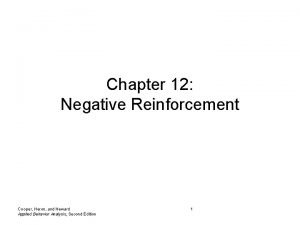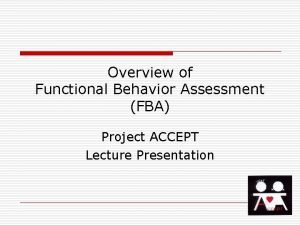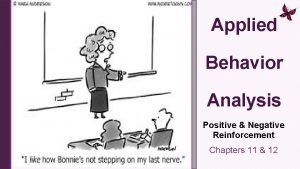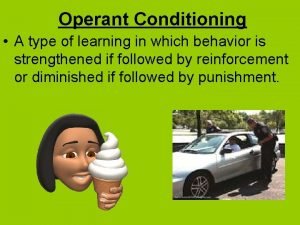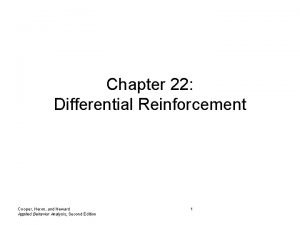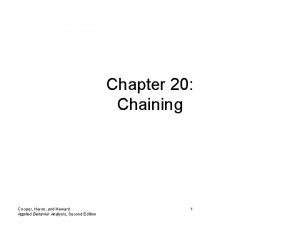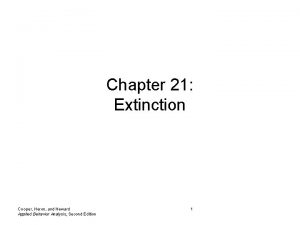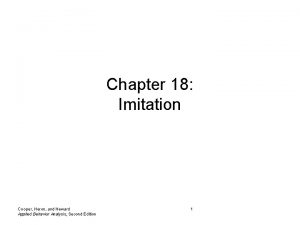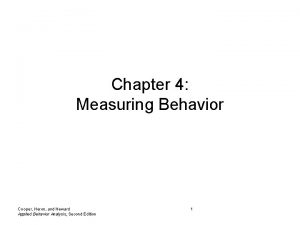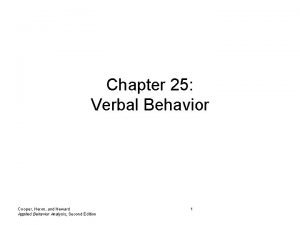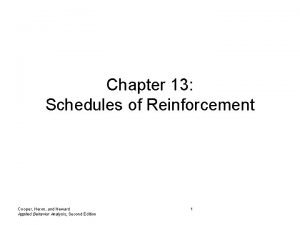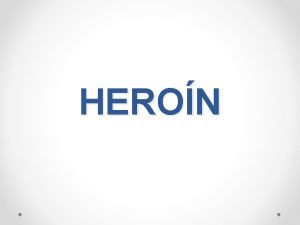Chapter 12 Negative Reinforcement Cooper Heron and Heward















- Slides: 15

Chapter 12: Negative Reinforcement Cooper, Heron, and Heward Applied Behavior Analysis, Second Edition 1

Definition • Stimulus removed (terminated, reduced, or postponed) • Contingent on a response • Which results in an increase in the future probability of that response Cooper, Heron, and Heward Applied Behavior Analysis, Second Edition 2

Escape Contingency • Includes 4 terms – Establishing operation • Antecedent event in the presence of which escape is reinforcing • An aversive stimulus – A discrimintive stimulus (SD) – A response – The reinforcer (termination of the EO) Cooper, Heron, and Heward Applied Behavior Analysis, Second Edition 3

Positive vs. Negative Reinforcement • How they are similar: – Both produce an increase in responding via a stimulus change • How they are different: – The type of stimulus change that follows the behavior • Positive reinforcement produces a stimulus that was absent prior to responding • Negative reinforcement terminates a stimulus that was present prior to responding Cooper, Heron, and Heward Applied Behavior Analysis, Second Edition 4

Positive vs. Negative Reinforcement Positive reinforcement: EO SD Response SR+ Absence of food for 2 hours Teacher says “Snack time” and apples on table “Apple, please” Apple presented Saying “Apple, please” when it is snack time and apples are present more likely in the future Negative reinforcement: EO SD Response SR- Math worksheet with 20 problems on student’s desk Teacher says “Complete 5 problems, then you don’t have to do the rest” Completes 5 problems Remaining problems on worksheet removed Cooper, Heron, and Heward Applied Behavior Analysis, Second Edition Completing problems when math worksheet and teacher instructions present more likely in the future 5 Copyright © 2008 by Pearson Education, Inc. All rights reserved

A difficulty… • Sometimes it can be difficult to determine whether the stimulus change was positive or negative – Turning up the heat • Adds heat • Removes cold – Free time contingent on work completion • Adds preferred activities • Removes work Cooper, Heron, and Heward Applied Behavior Analysis, Second Edition 6

A solution… • Michael (1975) suggested the distinction is not important • Instead, define key stimulus features – Before the stimulus change – After the stimulus change • This may provide a more complete, functional understanding of the relationship between the behavior and environment Cooper, Heron, and Heward Applied Behavior Analysis, Second Edition 7

Negative Reinforcement vs. Punishment • Often confused because: – “Positive” and “Negative” are opposites • But “positive” refers to presentation of the stimulus and “negative” refers to the termination of the stimulus – Both involve “aversive” events • But in negative reinforcement, the aversive event is present prior to the target behavior and in punishment, the aversive event is presented contingent on the target behavior • And the effect on behavior is different (negative reinforcement produces an increase in responding; punishment produces a decrease in responding) Cooper, Heron, and Heward Applied Behavior Analysis, Second Edition 8

Negative Reinforcement vs. Punishment Negative reinforcement: EO SD Response SR- Math worksheet with 20 problems on student’s desk Teacher says “Complete 5 problems, then you don’t have to do the rest” Completes 5 problems Remaining problems on worksheet removed SD Response SP+ Destroys worksheet Teacher requires student to complete all 20 problems Punishment: Teacher says “Complete 5 problems, then you don’t have to do the rest” Cooper, Heron, and Heward Applied Behavior Analysis, Second Edition 9 Completing problems more likely in the future when math worksheet and teacher instructions present Destroying worksheet less likely in the future when teacher makes work request

Escape and Avoidance Contingencies • Escape Contingency EO SD Response SR- Rain falling on your head as you walk down sidewalk Friend says “Do you have an umbrella? ” Put up umbrella Escape rain falling on your head Cooper, Heron, and Heward Applied Behavior Analysis, Second Edition Putting up umbrella more likely in the future when it’s raining and friend asks for umbrella 10 Copyright © 2008 by Pearson Education, Inc. All rights reserved

Escape and Avoidance Contingencies • Avoidance Contingency EO SD Response SR- Rain outside; you are still inside--nice and dry Friend says “Do you have an umbrella? ” Put up umbrella (prior to going outside) Avoid rain falling on your head Cooper, Heron, and Heward Applied Behavior Analysis, Second Edition Putting up umbrella more likely in the future when it’s raining and friend asks for umbrella 11 Copyright © 2008 by Pearson Education, Inc. All rights reserved

Characteristics of Negative Reinforcement • Any response (socially appropriate or inappropriate) can be strengthened by negative reinforcement – All are adaptive because they allow the individual to interact effectively with the environment • A variety of stimuli can serve as negative reinforcers – Unconditioned – Conditioned Cooper, Heron, and Heward Applied Behavior Analysis, Second Edition 12

Characteristics of Negative Reinforcement • Negative reinforcement can be – Socially mediated (delivered by another person) – Automatic (is produced directly by the person’s response) Cooper, Heron, and Heward Applied Behavior Analysis, Second Edition 13

Factors Influencing Effectiveness • As with positive reinforcement, negative reinforcement is most effective when – It is delivered immediately following the target behavior – The magnitude of reinforcement is large – It is delivered consistently – Reinforcement is unavailable for competing (nontarget) responses Cooper, Heron, and Heward Applied Behavior Analysis, Second Edition 14

Ethical Considerations • Like positive reinforcement, ethical issues arise from the severity of the EO that may need to be in place to motivate the occurrence of the behavior – The presence of particularly aversive antecedent stimuli may be problematic – These stimuli may generate undesirable competing behaviors Cooper, Heron, and Heward Applied Behavior Analysis, Second Edition 15
 Pre task choice aba
Pre task choice aba Cmo-s aba example
Cmo-s aba example Shaping across response topographies
Shaping across response topographies Cooper heron heward
Cooper heron heward Positive reinforcement psychology definition
Positive reinforcement psychology definition Aba antecedent interventions
Aba antecedent interventions When olivia makes rude noises at the dinner table
When olivia makes rude noises at the dinner table Learning through association
Learning through association Escape contingency aba
Escape contingency aba What are examples of negative reinforcement
What are examples of negative reinforcement Negative reinforcement example
Negative reinforcement example Generalization classical conditioning
Generalization classical conditioning Negative reinforcement meaning
Negative reinforcement meaning Human relations approach
Human relations approach Partial schedule of reinforcement
Partial schedule of reinforcement Fanning oneself to escape from the heat
Fanning oneself to escape from the heat
